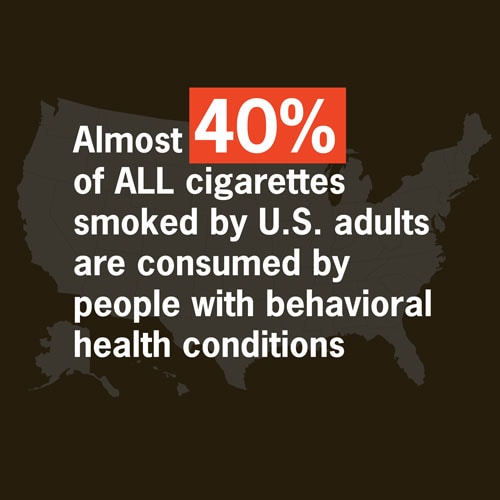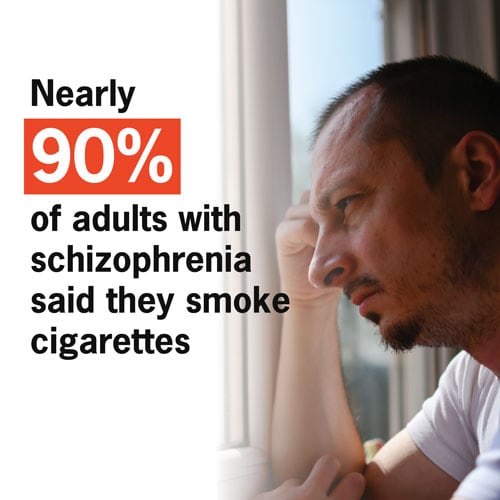People with Behavioral Health Conditions Experience a Health Burden from Commercial Tobacco

Approximately 1 in 4 adults in the United States (US) has a behavioral health condition such as a mental health condition and/or a substance use disorder.
Commercial tobacco* prevents achieving health equity for people with behavioral health conditions.1 For example:
- In 2019, 27.2% of adults with a mental health condition reported smoking cigarettes in the past month – compared to 15.8% of adults with no mental health condition.2
- The most common causes of death among people with behavioral health conditions are heart disease, cancer, and lung disease, which can all be caused by smoking.3,4,5
- People with mental health conditions who smoke cigarettes have two times the risk of premature death than people with behavioral health conditions who do not smoke.6
- People with behavioral health conditions are targets of aggressive commercial tobacco marketing.7,8
- People with behavioral health conditions may not be protected from secondhand smoke when seeking services in behavioral health treatment settings. Only about half of mental health treatment centers and one-third of substance use disorder treatment centers report having a smokefree campus.9 There is no safe level of exposure to secondhand smoke.
- People with certain diagnoses, such as depression and anxiety, or people substance use disorders (other than tobacco use disorder) are more likely to use commercial tobacco than those without these disorders.10,11,12,13 For example, nearly 90% of adults with schizophrenia reported smoking cigarettes in a 2006 survey.14
*“Commercial tobacco” means harmful products that are made and sold by tobacco companies. It does not include “traditional tobacco” used by Indigenous groups for religious or ceremonial purposes.
- Substance Abuse and Mental Health Services Administration. Results from the 2016 National Survey on Drug Use and Health: Detailed Tables. Rockville, MD: Substance Abuse and Mental Health Services Administration, Center for Behavioral Health Statistics and Quality, 2017 [accessed 2022 Feb 25].
- Center for Behavioral Health Statistics and Quality. (2020). Results from the 2019 National Survey on Drug Use and Health: Detailed tables. Rockville, MD: Substance Abuse and Mental Health Services Administration [accessed 2022 Feb 25].
- Druss BG, Zhao L, Von Esenwein S, Morrato EH, Marcus SC. Understanding Excess Mortality in Persons With Mental Illness: 17-Year Follow Up of a Nationally Representative US Survey. Medical Care 2011;49(6):599–604 [accessed 2022 Feb 25].
- Schroeder S A, Morris CD. Confronting a neglected epidemic: tobacco cessation for persons with mental illnesses and substance abuse problems. Annual Review of Public Health, 2010;31:297–314 [accessed 2022 Feb 25].
- Richter KP, Arnsten JH. A rationale and model for addressing tobacco dependence in substance abuse treatment. Substance Abuse Treatment, Prevention, and Policy. 2006;1(1):23 [accessed 2022 Feb 25].
- Tam J, Warner KE, Meza R. Smoking and the reduced life expectancy of individuals with serious mental illness. American Journal of Preventive Medicine. 2016; 51(6):958–966 [accessed 2022 Feb 25].
- Apollonio DE, Malone RE. Marketing to the marginalised: tobacco industry targeting of the homeless and mentally ill. Tob Control. 2005;14(6):409-415 [accessed 2022 Feb 25].
- Campbell BK, Le T, Andrews KB, Pramod S, Guydish J. Smoking among patients in substance use disorders treatment: associations with tobacco advertising, anti-tobacco messages, and perceived health risks. Am J Drug Alcohol Abuse. 2016;42(6):649-656 [accessed 2022 Feb 25].
- Marynak K, Vanfrank B, Tetlow S, et al. Tobacco Cessation Interventions and Smoke-Free Policies in Mental Health and Substance Abuse Treatment Facilities—United States, 2016. Morbidity and Mortality Weekly Report, 2018;67(18):519-23 [accessed 2022 Feb 25].
- Jamal A, Phillips E, Gentzke AS, et al. Current Cigarette Smoking Among Adults - United States, 2016. MMWR Morb Mortal Wkly Rep. 2018;67(2):53-59 [accessed 2022 Feb 25].
- Cook BL, Wayne GF, Kafali EN, Liu Z, Shu C, Flores M. Trends in Smoking Among Adults With Mental Illness and Association Between Mental Health Treatment and Smoking Cessation. JAMA. 2014;311(2):172–182 [accessed 2022 Feb 25].
- Dickerson F, Schroeder J, Katsafanas E, et al. Cigarette Smoking by Patients With Serious Mental Illness, 1999-2016: An Increasing Disparity. Psychiatr Serv. 2018;69(2):147-153 [accessed 2022 Feb 25].
- Young-Wolff KC, Hickman NJ 3rd, Kim R, Gali K, Prochaska JJ. Correlates and prevalence of menthol cigarette use among adults with serious mental illness. Nicotine Tob Res. 2015;17(3):285-291 [accessed 2022 Feb 25].
- NIH State‐of‐the‐Science Panel. National Institutes of Health State‐of‐the‐Science conference statement: tobacco use: prevention, cessation, and control. Ann Intern Med. 2006;145:839‐844 [accessed 2022 Feb 25].
- Centers for Disease Control and Prevention, Substance Abuse and Mental Health Services Administration, National Association of County Behavioral Health & Developmental Disability Directors, National Institute of Mental Health, The Carter Center Mental Health Program. Attitudes Toward Mental Illness: Results from the Behavioral Risk Factor Surveillance System. Atlanta (GA); Centers for Disease Control and Prevention; 2012 [accessed 2022 Feb 25].
- Prochaska JJ, Hall SM, Bero LA. Tobacco use among individuals with schizophrenia: What role has the tobacco industry played? Schizophr. Bull. 2008;34:555–67 [accessed 2022 Feb 25].
- Prochaska JJ, Smita D, Young-Wolff KC. Smoking, mental illness, and public health. Annual Review of Public Health. 2017; 38: 165-185[accessed 2022 Feb 25].
- Lawn S, Pols R. Smoking bans in psychiatric inpatient settings? A review of the research. Aust. N. Z. J. Psychiatry. 2005;39:866–85[accessed 2022 Feb 25].
- Cummings JR et al. Addressing public stigma and disparities among persons with mental illness: the role of federal policy. American Journal of Public Health. 2013;103(5): 781-5 [accessed 2022 Feb 25].
- Americans with Disabilities Act of 1990, Pub. L. No. 101-336, 104 Stat. 327 [accessed 2022 Feb 25].
- Patient Protection and Affordable Care Act, 2010, Pub. L. No. 111-148, 124 Stat. 119 [accessed 2022 Feb 25].
- Carson NJ, Rodriguez D, Audrain-McGovern J. Investigation of mechanisms linking media exposure to smoking in high school students. Prev Med. 2005;41(2): 511-20 [accessed 2022 Feb 25].
- Charlesworth A, Glantz SA. Smoking in the movies increases adolescent smoking: A review. Pediatrics 2005;116(6): 1516-28 [accessed 2022 Feb 25].
- U.S. Department of Health and Human Services. The Health Consequences of Smoking: 50 Years of Progress. A Report of the Surgeon General. Atlanta, GA: U.S. Department of Health and Human Services, Centers for Disease Control and Prevention, National Center for Chronic Disease Prevention and Health Promotion, Office on Smoking and Health, 2014 [accessed 2022 Apr 28].
- National Cancer Institute. The Role of the Media in Promoting and Reducing Tobacco Use. Tobacco Control Monograph No. 19. Bethesda, MD: U.S. Department of Health and Human Services, National Institutes of Health, National Cancer Institute. NIH Pub. No. 07-6242, June 2008 [accessed 2022 Apr 28].
- Young-Wolff KC, Henriksen L, Delucchi K, Prochaska JJ. Tobacco retailer proximity and density and nicotine dependence among smokers with serious mental illness. Am J Public Health. 2014;104(8):1454-1463 [accessed 2022 Feb 25].
- Robertson L, McGee R, Marsh L, Hoek, J. A systematic review on the impact of point-of-sale tobacco promotion on smoking. Nicotine & Tobacco Research. 2015;17(1): 2-17 [accessed 2022 Feb 25].
- Centers for Disease Control and Prevention. Vital Signs: Current Cigarette Smoking Among Adults Aged ≥18 Years With Mental Illness—United States, 2009–2011. Morbidity and Mortality Weekly Report 2013;62(5):81-7 [accessed 2022 Feb 25].
- Lohr JB, Flynn K. Smoking and schizophrenia. Schizophr Res. 1992;8(2):93-102 [accessed 2022 Feb 25].
- Prochaska JJ. Smoking and Mental Illness—Breaking the Link. New England Journal of Medicine, 2011;365:196-8 [accessed 2022 Feb 25].
- McEwen BS. Stress, adaptation, and disease. Allostasis and allostatic load. Ann N Y Acad Sci. 1998;840:33-44 [accessed 2022 Feb 25].
- Slopen N, Dutra LM, Williams DR, et al. Psychosocial stressors and cigarette smoking among African American adults in midlife. Nicotine Tob Res. 2012;14(10):1161-1169 [accessed 2022 Feb 25].
- Weinberger AH, Gbedemah M, Wall MM, Hasin DS, Zvolensky MJ, Goodwin RD. Cigarette use is increasing among people with illicit substance use disorders in the United States, 2002-14: emerging disparities in vulnerable populations. Addiction. 2018;113(4):719-728 [accessed 2022 Feb 25].
- Prochaska JJ, Delucchi K, Hall SM. A meta-analysis of smoking cessation interventions with individuals in substance abuse treatment or recovery. Journal of Consulting and Clinical Psychology. 2004;72(6), 1144 [accessed 2022 Feb 25].
- Compton W. The need to incorporate smoking cessation into behavioral health treatment. The American Journal on Addictions. 2018; 27(1):42–43 [accessed 2022 Feb 25].
- Taylor G, McNeill A, Girling A, Farley A, Lindson-Hawley N, Aveyard P. Change in mental health after smoking cessation: systematic review and meta-analysis. BMJ. 2014; 348:1151. [accessed 2022 Feb 25].
- Vital Signs: Adult Smoking Focusing on People with Mental Illness [PDF - 3.2 MB], February 2013 [accessed 2022 Feb 25].
- Substance Abuse and Mental Health Services Administration, Center for Behavioral Health Statistics and Quality. The N-SSATS Report: Tobacco Cessation Services. September 19, 2013. Rockville, MD [accessed 2022 Feb 25].
- Brown, CH et al. Factors influencing implementation of smoking cessation treatment within community mental health centers. Journal of Dual Diagnosis. 2015;11(2): 145-50 [accessed 2022 Feb 25].
- DiGiulio A, Jump Z, Babb S, et al. State Medicaid Coverage for Tobacco Cessation Treatments and Barriers to Accessing Treatments — United States, 2008–2018. MMWR Morb Mortal Wkly Rep 2020;69:155–160 [accessed 2022 Feb 25].
- Smoking Cessation Leadership Center. Fact Sheet: The Tobacco Epidemic Among People With Behavioral Health Disorders. San Francisco: Smoking Cessation Leadership Center, University of California, 2015 [accessed 2022 Feb 25].
- U.S. Department of Health and Human Services. Smoking Cessation. A Report of the Surgeon General. [PDF - 10 MB] Atlanta, GA: U.S. Department of Health and Human Services, Centers for Disease Control and Prevention, National Center for Chronic Disease Prevention and Health Promotion, Office on Smoking and Health, 2020 [accessed 2022 Feb 25].
- Davis KC, Duke J, Shafer P, Patel D, Rodes R, & Beistle D Perceived effectiveness of antismoking ads and association with quit attempts among smokers: evidence from the Tips from Former Smokers campaign. Health Communication. 2017; 32(8), 931-938 [accessed 2022 Feb 25].




